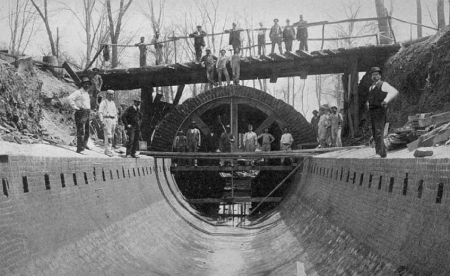
Wingohocking sewer under construction, 1914. (Photo: City Archives of Philadelphia)
An article earlier this month by NewsWorks’ Nicole Juday (sorry, this content is no longer available) examines the historical reasons for the flash flooding responsible for the drowning death of a young woman in East Germantown on September 8. The incident (news report here) occurred on high ground, far from any open streams; however, the location (Haines and Musgrave streets) is atop the buried Wingohocking Creek, one of many Philadelphia streams that were converted to sewers:
“Diverting streams into pipes was viewed as a way to protect clean water from contamination before it reached the Schuylkill, the source of Philadelphia’s drinking water. At the time, it was the largest city infrastructure project ever undertaken. To make the project more efficient, the pipes carrying streams were engineered to carry wastewater from indoor plumbing as well, a design known as a combined system. Stormwater would enter the pipes through intake grates, and wastewater from houses and businesses; all to be carried downstream to a wastewater treatment plant.
The sewer system designed a hundred years ago to safeguard the health of Philadelphians is still in use today, and by all accounts will be for many years to come. But encapsulating most of our waterways has come at a price, particularly in the case of the historic watershed of the Wingohocking Creek.”
In the September 8 incident, excessive rainfall (four inches in two hours) caused groundwater to push to the surface and cause flooding in streets and basements.